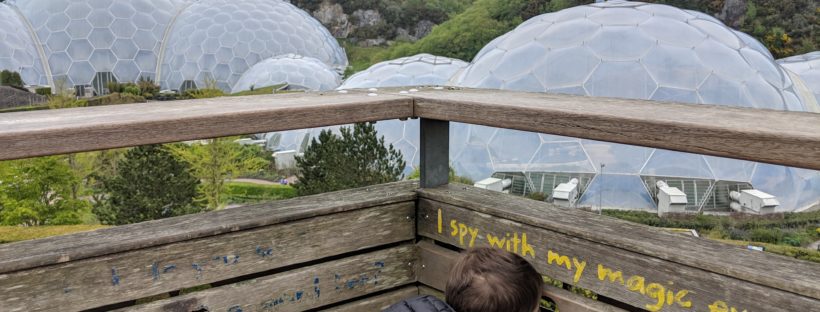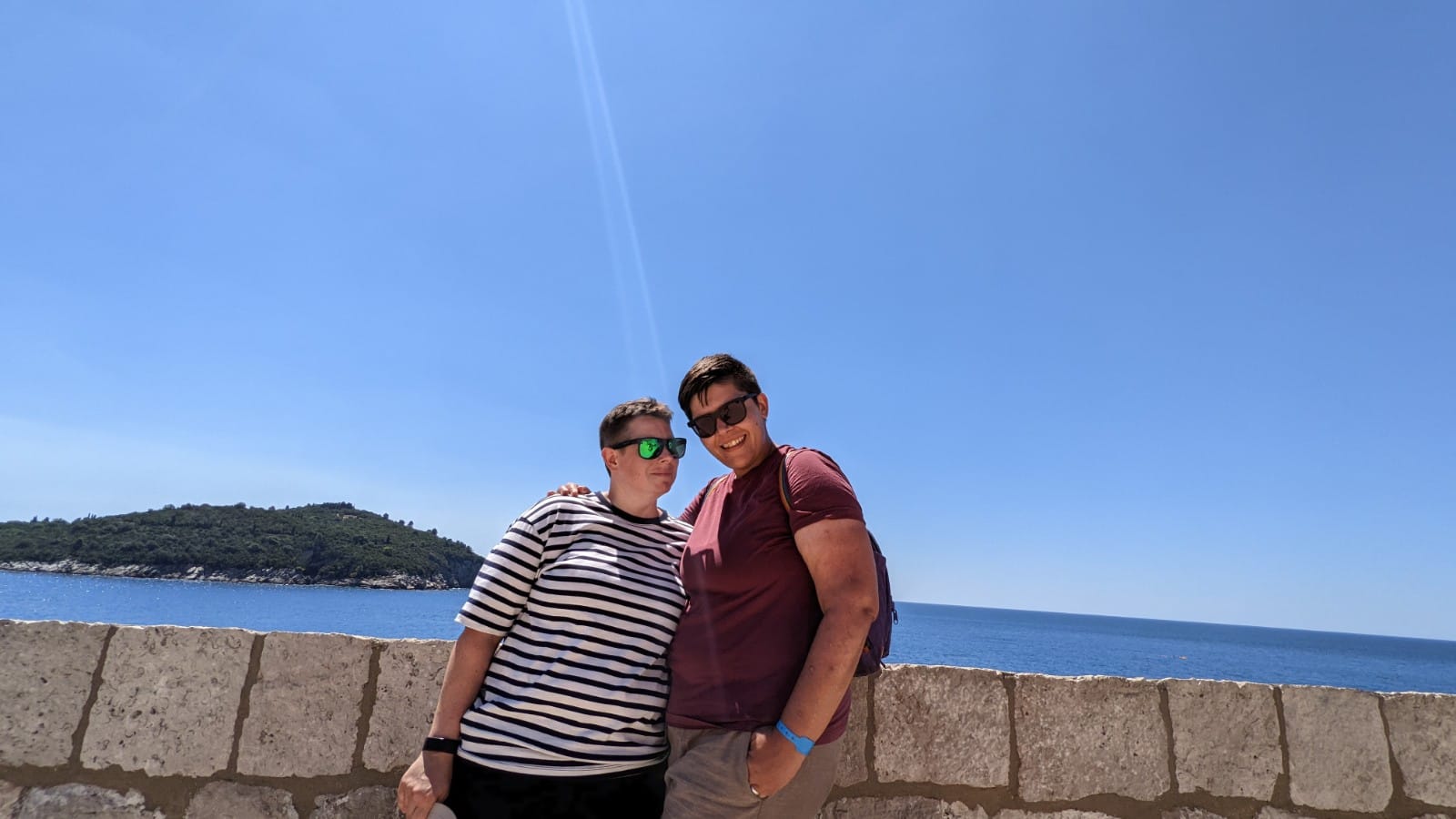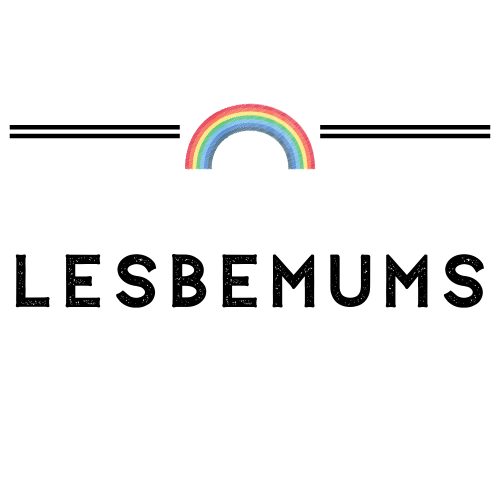Days Out: Eden Project, Cornwall [AD – Press Trip]

It was over ten years ago when Sharon and I first visited the Eden Project. We had just started dating and it was also our first proper holiday together. Embarrassingly, it didn’t start off too well due to the fact that I was completely unaware how bad Sharon suffered with Hayfever. She’s much better now, but at the time it probably wasn’t the best suggestion to take someone with Hayfever and mild Asthma to a place with tropical, hilly climates and thousands of plants(!).
That being said, despite the situation at hand, we still had a wonderful time, because the Eden Project is just that kind of place. It’s an awe inspiring mecca of sustainable living where you leave feeling incredibly motivated and empowered. A real Cornish gem.

If you haven’t been to the Eden Project, or would like to know more, let me explain what it’s about.
Creating eden
The Eden Project, an educational charity, connects us with each other and the living world, exploring how we can work towards a better future.
Created by Tim Schmidt at the bottom of a china clay pit that was coming to the end of it’s economic life, the aim was to create an educational facility around being more sustainable and looking after the planet; primarily around the use of plants. The initial ideas began back in 1995, however it wasn’t until March 2001 when the doors to Eden officially opened. Fast forward three months and over a million people have visited and it is crowned ‘the eighth wonder of the world’.
Over the next decade and beyond, the installation of rainforest treetop walkways and viewing galleries occur (that then get extended!), as well as the construction of an education centre, a winter ice rink, and a gigantic robot, weighing 3.3 tons, made of scrap metal is built. But that’s not all. There has been prestigious events, such as Live 8, hosted here, documentaries filmed (as well as Cbeebies’ very own Andy’s Safari Adventures), community camps, the opening of an on-site hostel made from shipping containers, and in July 2017, Eden ‘International’ launched.
Eden saw it’s 10 millionth visitor back in July 2010, and by their 10th birthday Eden had welcomed 13 million. With this in mind, it’s easy to say that the feeling you get with the Eden Project is contagious.

You probably already realise by now that I absolutely adore the Eden Project – and wholeheartedly believe in everything that it does – despite only visiting the once previously! There’s just something about it that makes you want to change the way you think about the products you use and how you treat the planet. I honestly do not know how they do it, because not once did I feel guilty as such, or like I was solely responsible for the planet’s demise, but somehow you take on board what they’re telling you and you leave wanting to do something, anything.
I wouldn’t class myself as an eco-warrior, and the thought of living in an eco-home scares me somewhat, but I am very aware of what we’re doing to this planet and it’s places like Eden Project that help (and encourage) you make those small changes. On the same note, if living eco-friendly really isn’t for you or you couldn’t give a monkey’s, the Eden Project is still a great place to visit thanks to beautiful gardens, wide paths for you to run around, and dozens of interactive exhibits to explore.



What’s at eden?
Eden starts from the moment you park your car / get off the bus thanks to the car parks being helpfully named after different fruits. It’s so important you remember your fruit as there are several car parks attached to the Eden Project, and if you’re like me you’ll easily forget your fruit and end up getting off a stop early and walking back up to your car. Regardless of where you park though, there is a shuttle bus that takes you from the car park to the main area, but you’re also welcome to walk from whatever car park you’re in. When we visited, we walked from the car park to Eden but got the shuttle bus back up again.
Once you arrive at the main area, you’re greeted by the main ticket office, which has grown significantly since we last visited (we remember when they were just booths!). In this area is also a lovely little coffee shop and an enormous gift shop, which I would recommend exploring at the end as you could be there some time.
As soon as you’ve purchased your tickets, you then go straight through to a viewing platform where you’re presented with the most amazing view. It’s difficult to imagine this being an old clay pit.


At this point, you have a choice of a few routes to take you down to the biomes. There’s the main zig-zag path, a more accessible path that’s not as steep (although the other path isn’t that steep, it’s just not as wheelchair-friendly) and the route via the land train which cuts out the walking all together. When we visited, we walked the accessible route as it looked the better route for T who likes to run off ahead of us. To plan ahead, you can have a look at the map here.


Our walk to the biomes took around 20-30 minutes as we took our time taking it all in and interacting with some of the built-in features along the walk. We also had lots of T-related questions to answer and several photo opportunities. Before making our way into the biomes, we also took a stroll around the gardens and checked out some of the temporary exhibits currently on display. Once we were ready, we then made our way to the Biomes entrance.

Entering Eden
Before entering the two main biomes, you go through the entrance area which is home to the main cafe and restaurant, another gift shop, and a smaller coffee booth. There’s also a self-service cloakroom and toilets – I highly recommend using both as both biomes are warm, even in the winter. There are also no toilets in the biomes (although it’s not a strict one way system, so you’re welcome to leave and come back at any point!).
Mediterranean Biome
Out of the two biomes, the Mediterranean Biome is the smaller and shorter one of the two – although it makes up for it’s size by housing the Med Terrace; a polite restaurant serving Mediterranean cuisine, from Paella to Salads to Antipasti. This sits in the centre of the dome and serves until 3pm, although on certain days you’re invited to book an evening meal. We decided to eat at the main restaurant when we visited, but the Med Terrace looked phenomenal. I definitely would have felt like I was on holiday whilst eating here.

Taking around an hour to explore – although its easy to spend longer here if you take part in any of the events; such as the story-telling session – the route takes you through the landscapes of South Africa, California and Western Australia with fresh herbs filling the air and bright flowers everywhere you look. There’s also several unique plants growing here such as cork trees, an array of citrus plants in their very own grove, grape vines, aloe plants, and the perfume garden. There’s also the iconic Bacchanalian sculptures.












We explored this biome last after some lunch, which was well planned as you need a lot more energy for the Rainforest Biome!
Rainforest Biome
The larger, and probably the more impressive of the two biomes, the Rainforest Biome is the home to the humid climates of Tropical Islands, Southeast Asia, West Africa and Tropical South America; which instantly greet you as you enter. Thanks to previous experience, we knew to dress light for this Biome, but for those who did not know what to expect we couldn’t help but giggle whilst walking through the cloud of tourists frantically disrobing.
As well as the heat, you’re instantly taken back by the enormous trees that tower over you (and keep towering over you no matter how high you get). There are over 1000 varieties of plant in this one Biome alone, as well as some roul-roul partridges and Sulawesi white-eye birds who roam free throughout the biome.









As you make your way to the top, you will pass several buildings and exhibits detailing rainforest life, as well as waterfalls and wall paintings. There’s also a Baobab Bar serving delicious smoothies, and the pièce de résistance; the rainforest canopy walkway right at the top, which offers breathtaking views across the forest (this is not the only route though if you have issues with accessibility). In addition, the new weather maker section includes a fully accessible cloud bridge (a welcome treat on a humid day) and an immersive exhibit where you can shelter from tropical rain storms.
If that’s not enough, there’s also the Rainforest Platform which opens sporadically throughout the day (due to the limited space up there they can only open it at certain times) as part of a separate tour (additional fees apply).








We easily spent half our day at the Eden Project biomes alone. There is so much to see and do, and some exhibits require some time to fully absorb. The canopy walk alone we walked a few times as it’s really fun (and bouncy!). T throughly enjoyed exploring both biomes and was fully immersed at one point whilst looking at all his favourite fruits growing on trees and bushes. As he gets older, I have no doubt that news things will capture him in different ways. He’ll also be in a better position to talk about some of the more challenging exhibits such as those about Palm Oil and deforestation.
Eating at Eden
As mentioned throughout, there are several places to eat and drink at the Eden Project – although picnics are also welcomed! It was actually quite surprising how much choice there was when it came to location, not to mention what to eat.


As well as several booths and huts selling hot drinks and ice creams, which are dotted around the Eden Project, there are the two main restaurants in between the two biomes; Eden Kitchen and Eden Grill, split at either end of Biome walkway. Offering a variety of dishes to serve all taste pallets and dietary requirements, there really is something for everyone – from meat dishes to vegan cuisine, dairy-free to gluten free – everyone is welcome. In addition, every thought has been put into sustainability when disposing of your lunch food when you’ve finished, as well as where they source their food.
We decided to eat at Eden Kitchen when it came to lunch and had the most amazing veggie/vegan wraps (I had pulled jackfruit and Sharon has Indian cauliflower. T had the same as me, but as part of a rice bowl instead which comes with a side of corn on the cob, and Sharon’s mum had one of the children’s lunchboxes as she was still full from breakfast). We also had a side of Cassava fries (google it, I had to) and drinks. I was so so impressed with the food. It was incredibly delicious and very reasonably priced for what you get and what you’re paying towards (our lunches cost us just under £30).


In addition to the main restaurants, there’s also the Med Terrace as mentioned, The Eden Pasty, and the Core cafe which is located at a different building; The Core.
As mentioned, Picnics are also welcome at Eden, with lots of places to sit down (covered or uncovered) as well as lots of recycling points for packaging and food waste. There are also several water filling stations dotted around for bottles, and if you bring a reusable cup with you you get a discount on hot drinks!
The Core
Once you’re done with the Biomes, the tour of Eden continues (and for us, finishes) at The Core, which is a complete change of scenery in comparison to the Biomes! I actually didn’t take many photos here as there was always something to see, touch, or do.
The Core’s sole purpose is around education, with several floors of interactive exhibits; enabled so you can see the floors whilst on other floors! Aside from what’s in The Core, the building itself is an eco-masterpiece thanks to the use of recycled content in the floors and walls, solar panels installed in the sunflower-themed roof, and water-saving measures in place in the kitchen and toilets. Even the chairs in the cafe are made from bamboo.

Although The Core was built in 2005, it was redesigned in 2017/2018 and re-opened with an Exhibitions Gallery, the Core Cafe, a fully interactive Laboratory, and two small play areas, whilst also keeping the original favourites such as Seed. There’s also regular guest exhibitions and art installations. A main feature for The Core, which will now remain as a permanent exhibit, is the Invisible Worlds exhibit; which introduces the interconnectedness between life and the Earth’s environments at different stages. Art most definitely meets science!




Our favourite piece was most definitely Infinity Blue which is this gigantic blue ceramic structure sitting at an impressive 8.5 meters tall (almost to the roof of The Core!) which is dedicated to cyanobacteria – the beginning of the production of oxygen.
This incredibly interactive piece blows puffs of smoke in the shape of rings at random and slowly builds to a giant crescendo. The children who attended were immersed and it took us a good half an hour of watching T chase the smoke rings before we could pull him away. Plus, it was actually a really calming watch and got us thinking about a number of things.




Value for money?
We had an absolutely wonderful time at the Eden Project and cannot recommend it more – even just to say you’ve seen it! We arrived just after opening and stayed to almost closing time. T interacted with everything and was still talking about it a few days later. There is so much to see and do, and it had such a friendly and relaxing atmosphere. If we lived closer we absolutely would take out a yearly membership – although I’m not sure whether my wallet could handle regular visits to the gift shop.
Our visit was part of a review*, however if we were paying it would have cost us £85 for three adults (0-4 are free! 5-16 are £15), which I do appreciate sounds steep, but in comparison to attractions in London it is no different (Eden Project is actually almost the same cost as The Tower of London) and you’re putting towards something so vital, even more so now.
The Eden Project is much more than a visitor attraction; as a charity we provide unforgettable learning experiences to inspire future generations. Our community work ranges from a weekly lunch club tackling isolation amongst the elderly to The Big Lunch, connecting millions across the Commonwealth. And we’re involved in multiple conservation projects.
Your support through admission or Membership helps us to continue the work we do – thank you.
Looking at the price list, there are lots of deals you can take advantage of; such as booking in advance to save 10% or group savings if you’re a family (2 x adults, 2 x children). There are also discounts if you arrive on foot, bike, or public transport, as well as vouchers which can be found in a variety of tourist booklets. You can also use your Tesco vouchers!
With this in mind, I’m going to say that you absolutely get value for money as long as you’re not expecting a cheap day out! Obviously there are ways you can save money (bring re-usable cups and bottles for drinks, or a picnic for lunch) but if this wasn’t a review* trip we would have spent in the region of £120 (minus the gift shop – oops) which is no different to a day out at a London attraction or a theme park. I’d be happy to pay that based on what you’re investing in.
Have you been to the Eden Project? What did you think?

*We received complimentary tickets to the Eden Project in exchange for an honest review, however all thoughts, opinions, and imagery are our own.


Oh I want to go back! The last time I went to the Eden Project I was 36 weeks pregnant with Athena. I think we’re due another visit! x
Definitely!! It gets better every time we visit.